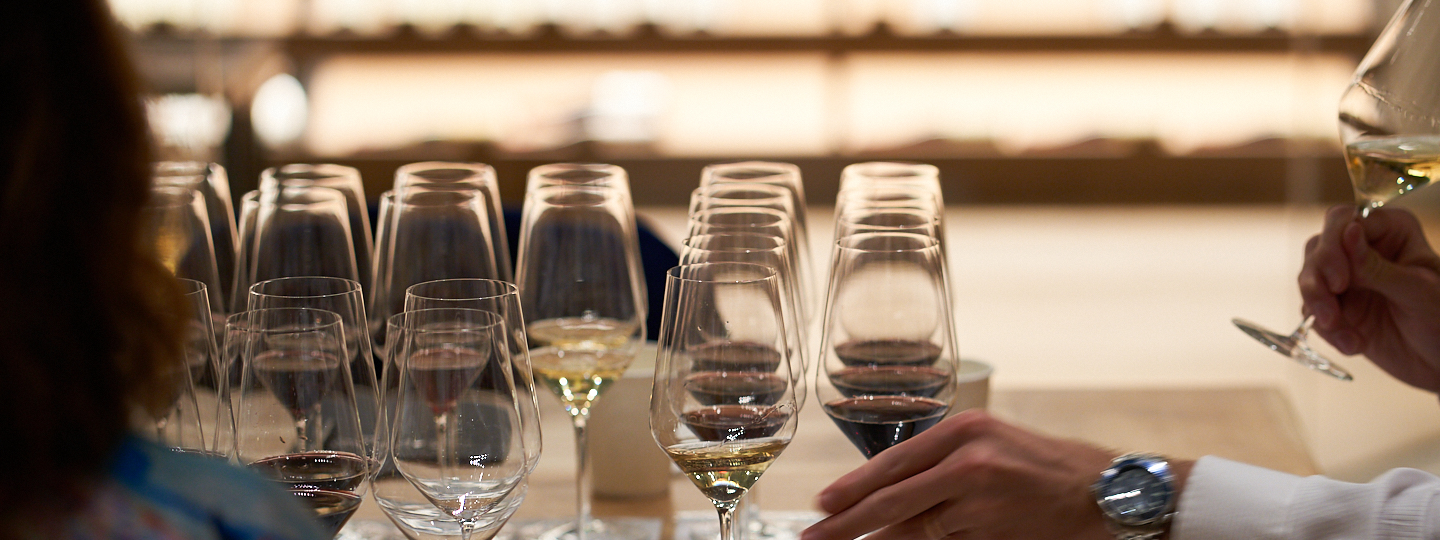

In this blind tasting session, we select five wines, serve them blind and, as a group, work deductively through the tasting process to uncover the wine. The trick here is we actually serve ten wines – two wines with something in common, served in pairs.
1st Pair: 2011 Domaine Billaud-Simon Chablis Vaudésir Grand Cru & Les Clos Grand Cru
We begin our blind tasting session this time in Chablis. This pair features the 2011 vintage of the grands crus vineyards “Les Clos” and “Vaudésir” both produced by Domaine Billaud-Simon. Les Clos is seen as the best vineyard of all Chablis by many. The domaine owns 0.47 hectares and it’s planted with 60 years old vines in average at about 140m to 170m above sea level on kimmeridjian soils mainly composed of clay and limestone. The vineyard is exposed south on steep slope. It also owns a 0.70 hectares of plot in Vaudésir, which is located in enclosed valley with little air circulation that benefits grape ripeness, which also has south exposure. Their style is to ferment and age their wines primarily in stainless steel vats to promote freshness and minerality in the wine. The wines also tend to be bottled late. Some of their premiers crus and grands crus spend a small amount of time in oak barrels depending on the vintage and vineyard. For ‘Vaudésir’ 100% is vinified in oak barrels. In 2014, Domaine Faiveley purchased Domaine Billaud-Simon.
2nd Pair: 2012 & 2015 Biondi Santi - Brunello di Montalcino Annata
Ferruccio Biondi-Santi is recognized as the inventor of Brunello. When phylloxera and downy mildew came to Italy, many winemakers looked to make wines for drinking early, but Ferruccio wanted to make wines for long ageing, so he grafted the estate’s new vines with Sangiovese Grosso and started producing wines from 100% Sangiovese. By doing that, he was able to break free from the regulations for Chianti and created a Brunello wine of longevity.
The Annata is from vines that are between 10-25 years old, so these are younger vines than those used in the Riserva which are over 25 years old and only made in good years. However, the ageing of both wines is the same, it takes place in Slavonian oak casks for 36 months.
3rd Pair: 2000 Château La Conseillante & Vieux Château Certan
Vieux Château Certan is a blend of predominantly Merlot and Cabernet Franc with the percentages changing depending on which grape was best for the vintage and also includes Cabernet Sauvignon. The vineyard comprises 14 hectares and is planted to 70% Merlot, 25% Cabernet Franc and 5% Cabernet Sauvignon. It includes one of the oldest plots in Pomerol with a parcel of Merlot that was planted back in 1932. This estate dates back to the 1700s and is located in the centre of the Pomerol on the plateau. The soil is made up of clay and gravel as well as deep blue clay which is particularly well suited for cultivating Merlot.
La Conseillante has its own unique feature, and that is its position. Its soils are not only on the Pomerol plateau but also cross over into the Saint-Émilion appellation. Its vineyard covers 12 hectares and stretches from the clay soils close to Pétrus (to the north-east) as far as the gravel soils next to Cheval Blanc (to the south-west). The soil is composed of 60% clay and 40% sandy gravel planted with vines averaging 35 years (oldest vines are planted in 1958). The wine is matured 18 months in 60% to 80% new French oak.
4th Pair: 2017 Domaine Amiot-Servelle – Clos-St.-Denis & Morey-St.-Denis
Domaine Amiot-Servelle gets its name from the merging of two Burgundy families. Christian Amiot, the son of Pierre Amiot, married Elisabeth Servelle, the daughter of Jean Servelle of Domaine Servelle-Tachot. Then, in 1990 the name of the estate was changed to Domaine Amiot-Servelle. The Domaine comprises 8 hectares including 0.17 ha in Clos-St.-Denis facing east on steep slope with soil composed of marl, and for Morey-St.-Denis village, the cuvée comes mainly from 0.46 ha in Clos Solon and a small parcel in Les Bras. The vines are 50 years in average planted in soil composed of limestone with pebbles. The domaine uses stainless steel vats with temperature control to ferment the wines in order to control the extraction of the grapes and to keep more sanitary conditions during the process. They do five days of cold maceration after the grapes are harvested to develop fresh aromas in the berries, and they use natural yeast. The work is done the same way for each vat because they want the terroir to show through in the wines rather than the winemaking. Maturation is 18 months in 20% new oak for the village level wines and 50% new oak for the grand cru and their 1ers crus.
5th Pair: 2007 Tenuta dell’ Ornellaia - Masseto & Le Macchiole - Messorio
Masseto is considered by many as the “Petrus” of Italy; it’s made entirely of Merlot. The first vintage was made in 1986, and it was also created by Lodovico Antinori. Only 32,000 bottles are produced each year. The wine is aged in 100% new fine oak barrels. Similar to the process at Ornellaia, the base wines are vinified separately, and after they’re blended the wine undergoes a second year of ageing prior to release. Masseto showcases Merlot at its finest and is a bargain in comparison to its French counterparts in the Pomerol at that level.
Messorio first came from experimental planting of Merlot In Bolgheri, the name “messorio” refers to the wheat harvest. The wine is made with 100% merlot from vines averaging 30 years, which were planted in few different plots (Casa Vecchia, Casa Nuova, Puntone, and Vignone). Fermentation and maceration process takes 20 days, and maturation is 16 months in new French oak barrels.
